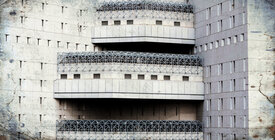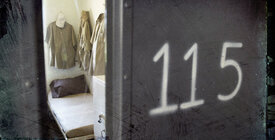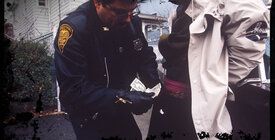This essay is part of the Brennan Center’s series examining the punitive excess that has come to define America’s criminal legal system.
There is a widely accepted narrative about incarceration in the United States that goes something like this:
At the dawn of the Reagan era in a nation of 225 million Americans, the incarcerated population was a little more than half a million people with 8 percent behind bars for drug offenses. The “War on Drugs” that raged throughout the 1980s and into the next decade — bringing with it statutory reforms that relied heavily on increased policing, incarceration, and mandatory sentencing — caused the imprisonment rate to more than triple to 695 per capita with 24 percent serving time for drug offenses. As a result, nearly 2.3 million people are locked up in the United States today. And the march toward this mass incarceration occurred with Black Americans squarely underfoot, trampling their communities and imprinting racial disparity onto the nation’s criminal justice system.
That story isn’t wrong, but it is incomplete. In this all-too-common telling, punitive excess, mass incarceration, and racial disparity are comingled — a grim tale of three tragic characters arising together from the carceral policies of the last four decades. It would follow, then, that to address one of them would be to make inroads against them all. But this logic is much too thin, mostly serving to make a long story short.
Instead, the more accurate account of imprisonment in the United States reveals that punitive excess, mass incarceration, and racial disparity are distinct phenomena. One need only catalog the experiences of racial and ethnic minorities to discern that if mass incarceration and punitive excess were abolished tomorrow, racial disparities would still exist in the range of socioeconomic factors that influence one’s life chances and unduly expose people of color to punishment and whatever social penalties take the place of confinement.
This spotlights an ugly truth lurking within the nation’s structures and policies — one that the criminal justice system crystallizes with astonishing clarity: the unwillingness to confront a history of racial oppression and the continued devaluation of people of color make full equality and justice in America unattainable. To establish a fair and unbiased justice system loosened from punitive excess and mass incarceration, we must reckon with the central role race plays in systemic outcomes.
The entrenchment of racial hierarchy in the United States began before the nation came to be and has long endured. The nation’s founding era featured forced displacements, chattel slavery, indentured servitude, outright denials of citizenship, and dehumanization of Native Americans, Black people, and immigrants of different races and ethnicities arriving to the New World. Even a civil war could not straighten out the racial oppression that the nation had wrought.
Though the civil rights movement a century later helped the nation painstakingly move toward becoming a more inclusive democracy race remained a primary social determinant of the measure of justice and citizenship one could access. Racial hierarchy and inequality coursed in the nation’s bloodstream, infecting every aspect of our society and pooling in the criminal justice system.
Its fingerprints are everywhere. White segregationists’ sanctioned vigilantism and terrorism focused its attention on Black people. The federal government forcibly corralled more than 120,000 Japanese Americans into internment camps during World War II while sparing nearly all Americans of German and Italian descent. Today, Latino immigrants and undocumented denizens are caged in detention facilities and separated from their families, and Black Americans are incarcerated at alarmingly high rates and are overrepresented in punitive excesses such as solitary confinement and the death penalty.
This history and the policies it birthed resulted in a conflated ontology of race, social threats, and crime. That is, sociologists and political scientists have found that, in a society with a built-in racial hierarchy, the visual markers of race and ethnicity create boundaries of trust and empathy, leading to civic and social distance between citizens. When certain communities of color are treated like a scourge and caricatured as incompatible with American values, their very presence can create a heightened sense of insecurity in the broader society. The criminal justice system has been fashioned to manage these societal anxieties by exerting control over the population deemed a danger to the American way of life.
The Black American experience at the turn of the twentieth century is an example of this sociology in motion. In the early decades of the Great Migration, when millions of Black Americans left the brutality and economic insecurity of the South to seek opportunities in northern and midwestern states, they encountered communities of white European immigrants who were themselves often discriminated against and treated as second class citizens. The ensuing competition for employment and housing — as well as a desire for their own social advancement — caused many white citizens to set aside nativist resentments toward white European immigrants and unite in opposition to the Black arrivals.
These immigrants were able to secure patronage jobs, particularly in law enforcement, as a buffer between Black Americans and white political and economic elites. Research reveals that the rate of arrest and incarceration of Black Americans in Great Migration destination cities increased as the proportion of white immigrants on local police forces increased. Charges for petty offenses against Black people skyrocketed, turning accusations of crimes like suspicious behavior, disorderly conduct, and public drunkenness into instruments for social control.
As Martin Luther King Jr. said upon remembrance of the work of renowned sociologist and historian W.E.B. DuBois, so long as the devaluation of Black people persisted, “the brutality and criminality of conduct toward the Negro was easy for the conscience to bear. The twisted logic ran: If the black man was inferior, he was not oppressed.”
In the end, we have a system where justice is delivered unevenly and, at times, arbitrarily. It’s as if structural racism compels Lady Justice to lift her blindfold and slant her scales, forcing some of her people at the margins to tumble off the edge beyond her reach.
Any serious attempts at reform and making our justice system truly just will require a direct confrontation with what African American studies scholar Eddie Glaude Jr. calls the value gap. This is the idea that the true plague in American society is that people of color, particularly Black people in a nation where chattel slavery featured so prominently, are simply valued less. As such, no matter what law and policy is implemented with racial justice and equality as its goal, if the value gap is left unaddressed, Glaude argues, “our systems will always produce the same results: racial inequality.”
There is no way around this quandary. It is a product of our history that people of color remain overly exposed to the darkest corners and worst impulses of our criminal justice system, its institutions and practices, and its actors. Reimagining justice in America requires a color-conscious approach to policy, employing measures and taking actions that account for people’s disparate paths and experiences. Perhaps this is why in her initial conception, Lady Justice wore no blindfold — when a system is truly just, it doesn’t need to be blind to be impartial or equitable.
At the same time, policy reforms to end mass incarceration and cease excessive punishment are critically important. Treating the threat of incarceration as a last resort instead of a first response to any social problem is an unassailable good for any fair and just society. Respecting the humanity and dignity of all people by refusing to subject them to cruel and unusual punishments not only helps us live up to our constitutional principles, but it also ushers the United States one step closer to being the more perfect union outlined in its national canon.
That goal, however, remains a distant one — no other people imprison each other more than Americans. And Louisiana embodies this peculiarity in superlative fashion. It has the highest incarceration rate in the country, and Fair Bryant knows this better than anyone. Bryant, a Black man who served time in the state’s infamous prison known as Angola, was sentenced to life upon being convicted of attempting to steal hedge clippers in 1997. His fate was the product of punitive excess hallmarks — habitual offender laws, harsh mandatory sentencing, and forced field labor in an institution that owns the horrific distinction of holding two men in solitary confinement for nearly four decades, the longest period in American history.
For Bryant, like too many others, the criminal justice system has been anything but fair. Bryant’s life is stark reminder that ending mass incarceration and eradicating punitive excess should neither shake us from being clear-eyed about the outsize role race plays in America nor stuff these policy reforms into racial justice frames for political expediency’s sake. We must tell the whole story of incarceration in the United States, complete with its ugly bits and filled with all its details, complexities, and nuances. Only then will we be able to bring our system to justice.







